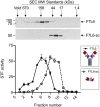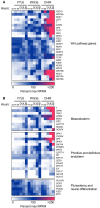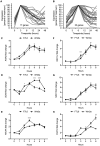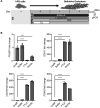Selective activation of FZD7 promotes mesendodermal differentiation of human pluripotent stem cells
- PMID: 33331818
- PMCID: PMC7759383
- DOI: 10.7554/eLife.63060
Selective activation of FZD7 promotes mesendodermal differentiation of human pluripotent stem cells
Abstract
WNT proteins are secreted symmetry breaking signals that interact with cell surface receptors of the FZD family to regulate a multitude of developmental processes. Studying selectivity between WNTs and FZDs has been hampered by the paucity of purified WNT proteins and by their apparent non-selective interactions with the FZD receptors. Here, we describe an engineered protein, called F7L6, comprised of antibody-derived single-chain variable fragments, that selectively binds to human FZD7 and the co-receptor LRP6. F7L6 potently activates WNT/β-catenin signaling in a manner similar to Wnt3a. In contrast to Wnt3a, F7L6 engages only FZD7 and none of the other FZD proteins. Treatment of human pluripotent stem (hPS) cells with F7L6 initiates transcriptional programs similar to those observed during primitive streak formation and subsequent gastrulation in the mammalian embryo. This demonstrates that selective engagement and activation of FZD7 signaling is sufficient to promote mesendodermal differentiation of hPS cells.
Keywords: WNT; developmental biology; human; pluripotent stem cells; regenerative medicine; signal transduction; stem cells.
© 2020, Gumber et al.
Conflict of interest statement
DG, MD, NS, PS, CW, LC, SG, DC, TG, KW No competing interests declared
Figures















Similar articles
-
Selective activation of FZD2 and FZD7 reveals non-redundant function during mesoderm differentiation.Stem Cell Reports. 2025 Feb 11;20(2):102391. doi: 10.1016/j.stemcr.2024.102391. Epub 2025 Jan 16. Stem Cell Reports. 2025. PMID: 39824186 Free PMC article.
-
The WNT receptor FZD7 is required for maintenance of the pluripotent state in human embryonic stem cells.Proc Natl Acad Sci U S A. 2014 Jan 28;111(4):1409-14. doi: 10.1073/pnas.1323697111. Epub 2014 Jan 13. Proc Natl Acad Sci U S A. 2014. PMID: 24474766 Free PMC article.
-
Expression of Frizzled5, Frizzled7, and Frizzled10 during early mouse development and interactions with canonical Wnt signaling.Dev Dyn. 2007 Jul;236(7):2011-9. doi: 10.1002/dvdy.21198. Dev Dyn. 2007. PMID: 17576136
-
Regulation of WNT signaling molecules by retinoic acid during neuronal differentiation in NT2 cells: threshold model of WNT action (review).Int J Mol Med. 2002 Dec;10(6):683-7. Int J Mol Med. 2002. PMID: 12429992 Review.
-
WNT/Frizzled signalling: receptor-ligand selectivity with focus on FZD-G protein signalling and its physiological relevance: IUPHAR Review 3.Br J Pharmacol. 2014 Mar;171(5):1195-209. doi: 10.1111/bph.12364. Br J Pharmacol. 2014. PMID: 24032637 Free PMC article. Review.
Cited by
-
Design principles and therapeutic applications of novel synthetic WNT signaling agonists.iScience. 2024 May 8;27(6):109938. doi: 10.1016/j.isci.2024.109938. eCollection 2024 Jun 21. iScience. 2024. PMID: 38832011 Free PMC article. Review.
-
Exploiting spatiotemporal regulation of FZD5 during neural patterning for efficient ventral midbrain specification.Development. 2024 Mar 1;151(5):dev202545. doi: 10.1242/dev.202545. Epub 2024 Mar 4. Development. 2024. PMID: 38358799 Free PMC article.
-
6-Bromoindirubin-3'-Oxime Regulates Colony Formation, Apoptosis, and Odonto/Osteogenic Differentiation in Human Dental Pulp Stem Cells.Int J Mol Sci. 2022 Aug 4;23(15):8676. doi: 10.3390/ijms23158676. Int J Mol Sci. 2022. PMID: 35955809 Free PMC article.
-
A desert lncRNA HIDEN regulates human endoderm differentiation via interacting with IMP1 and stabilizing FZD5 mRNA.Genome Biol. 2023 Apr 24;24(1):92. doi: 10.1186/s13059-023-02925-w. Genome Biol. 2023. PMID: 37095549 Free PMC article.
-
LRPs in WNT Signalling.Handb Exp Pharmacol. 2021;269:45-73. doi: 10.1007/164_2021_526. Handb Exp Pharmacol. 2021. PMID: 34490514 Review.
References
-
- Chen G, Gulbranson DR, Hou Z, Bolin JM, Ruotti V, Probasco MD, Smuga-Otto K, Howden SE, Diol NR, Propson NE, Wagner R, Lee GO, Antosiewicz-Bourget J, Teng JM, Thomson JA. Chemically defined conditions for human iPSC derivation and culture. Nature Methods. 2011;8:424–429. doi: 10.1038/nmeth.1593. - DOI - PMC - PubMed
Publication types
MeSH terms
Substances
Associated data
- Actions
Grants and funding
LinkOut - more resources
Full Text Sources
Molecular Biology Databases
Research Materials

